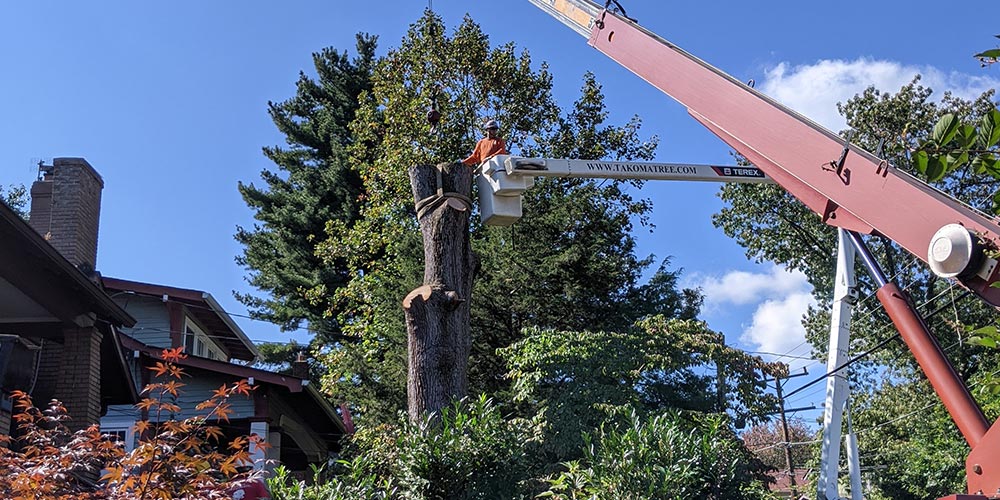
Tree Removal: To Axe or Not to Axe
While dead or dying trees in natural areas are rarely dangerous to people or property, those near roads, homes, and power lines can be hazardous if they have structural flaws that could cause them to fall.
You should give immediate attention to trees that could injure people or damage property and determine if and how you should remove them.
If you are concerned about the tree’s overall health, you should have it evaluated by a certified arborist services provider. Certified arborists are experts in many elements of tree maintenance, and you should contact them when assessing a tree’s health to determine whether you should remove it.
When is it the right time to remove a tree?
You should consider removing a tree if it’s dead. A tree is doomed if it hasn’t had any green leaves for the growing season.
The tree needs serious attention if it has new, unsealed wounds or long cracks in the trunk.
The tree can also be problematic if it has abnormally peeling bark and multiple branches with fungi.
Another scenario that may require removal is if the entire trunk tilts 30 degrees or more off-center.
You should note that deciding whether or not to remove a tree becomes more difficult if the tree is still alive but has been severely injured or is in poor health or decay.
In such an instance, hire a certified arborist with the proper knowledge and experience to determine the tree’s health and help you decide if to save or remove it.
Consider the 25% rule.
The 25% rule determines a tree’s resilience following harm.
The tree will likely survive if 25% or less of the crown is damaged. If your tree has that type of damage, you should remove the broken branches and reshape the tree.
In certain cases, the tree can still survive even if 50% of the crown is damaged, mainly if the damage is concentrated on smaller branches. It depends on the location and severity of the damage.
While this is the case, you should note that if the tree has a new gaping wound that won’t heal and a considerable amount of crown loss, it would most likely not recover. The same holds if a trunk has a large vertical crack down its length induced by a lightning strike or wind torquing.
Besides the branches, the 25% rule applies to tree root systems injured by excavation or other means, mainly when the damage is to smaller, less supporting roots.
To avoid being caught unaware, you should monitor the trees annually. You should get conversant with the tree’s overall health and be on the lookout for symptoms of deterioration to determine whether the tree requires removal.
So, if you are wondering when is the best time to remove a tree, you don’t have to worry too much, as the tree will guide you in making the decision.
Consider removing a tree that is in the wrong location
Planting the wrong type of tree or planting a tree in an improper area can both result in the need for tree removal.
The wrong tree for a location can endanger people. For example, a tree growing under a power line can pose a major safety risk if one of its limbs collapses, causing the wire to break. For such an instance, you should choose a shorter tree.
If a tree is not properly adapted to the environment in which it is placed, it may survive for several years but will often be sickly, have limited development, and have a less-than-optimal appearance.
For the tree to realize its true potential, you should remove it from the undesirable location and move it elsewhere.
When planting a tree, you should not only plant it at the right location but also plant it at the right time.
September to November is the best season for tree planting since it allows the roots to grow before the ground freezes and winter sets in. You should avoid planting trees later in the fall since it may harm plant health.
Remove invasive trees
While certain alien tree species might thrive in your home, they threaten native trees.
While you can keep many types of trees in your home, there are some you should stay away from. For example, avoid Chinese tallow, chinaberry, and Bradford pear trees.
Chinese tallow may swiftly eliminate and replace natural tree species. Leaves and fruits might also be poisonous to humans and cattle.
Chinaberry trees are filthy due to their leaves and berries falling, which can be toxic to humans and cattle.
Bradford pear trees can grow 30 feet tall but have a weak branch structure that can break apart in less than 20 years, posing a risk to anybody nearby when they fall.
If you have any of these trees in your home, it might be a wise idea to remove.
Other features you should look out for to tell it’s time to remove trees include:
- Are susceptible to breaking.
- Drop a significant amount of debris.
- Have shallow roots that can harm lawns and pavements.
- Are more sensitive to illness and insect pressure.
You shouldn’t remove trees by yourself.
Even if your tree is ripe for removal, you shouldn’t remove it yourself. This is because the tree poses an excellent danger, especially if it’s enormous.
You also might be unable to properly remove it due to a lack of the necessary tools.
To be on the safe side, you should hire professional tree removal services Bethesda to remove the tree safely. The professionals have the necessary tools so that safety won’t be an issue. The professionals are experienced, so you won’t worry about them messing up and damaging your property.
To be safe, do background checks and ensure the contractor you hire is experienced and certified to work in your local area.
